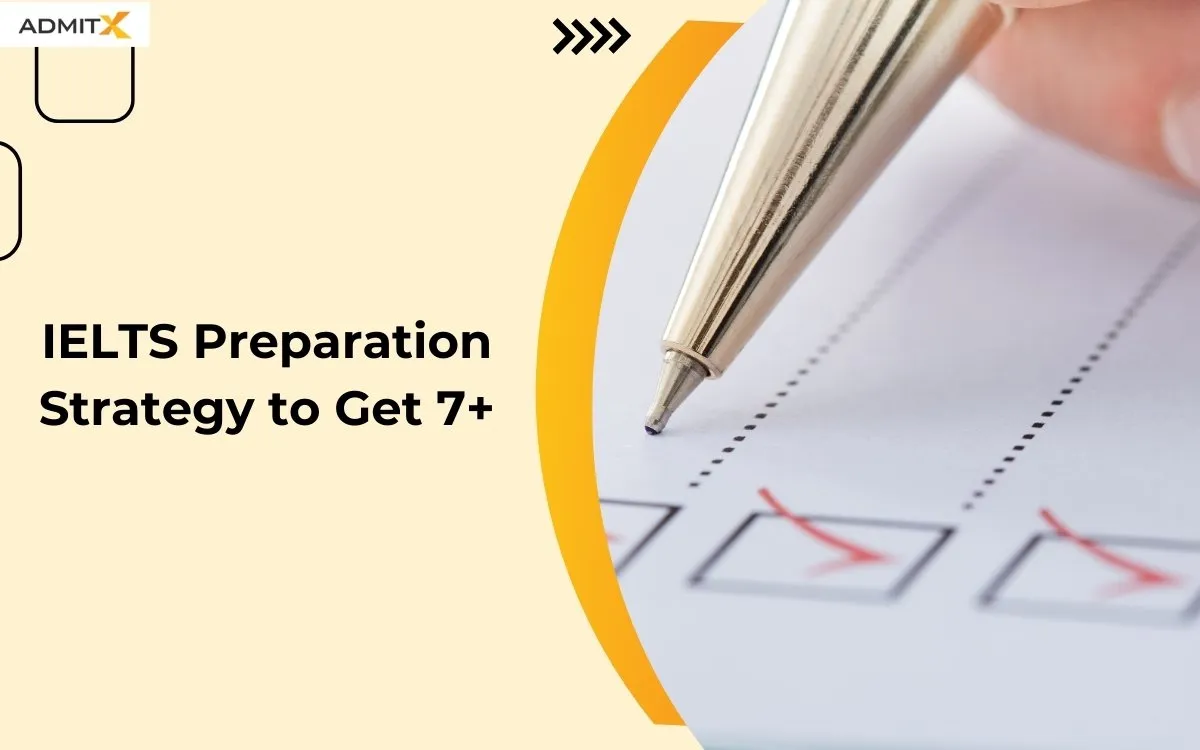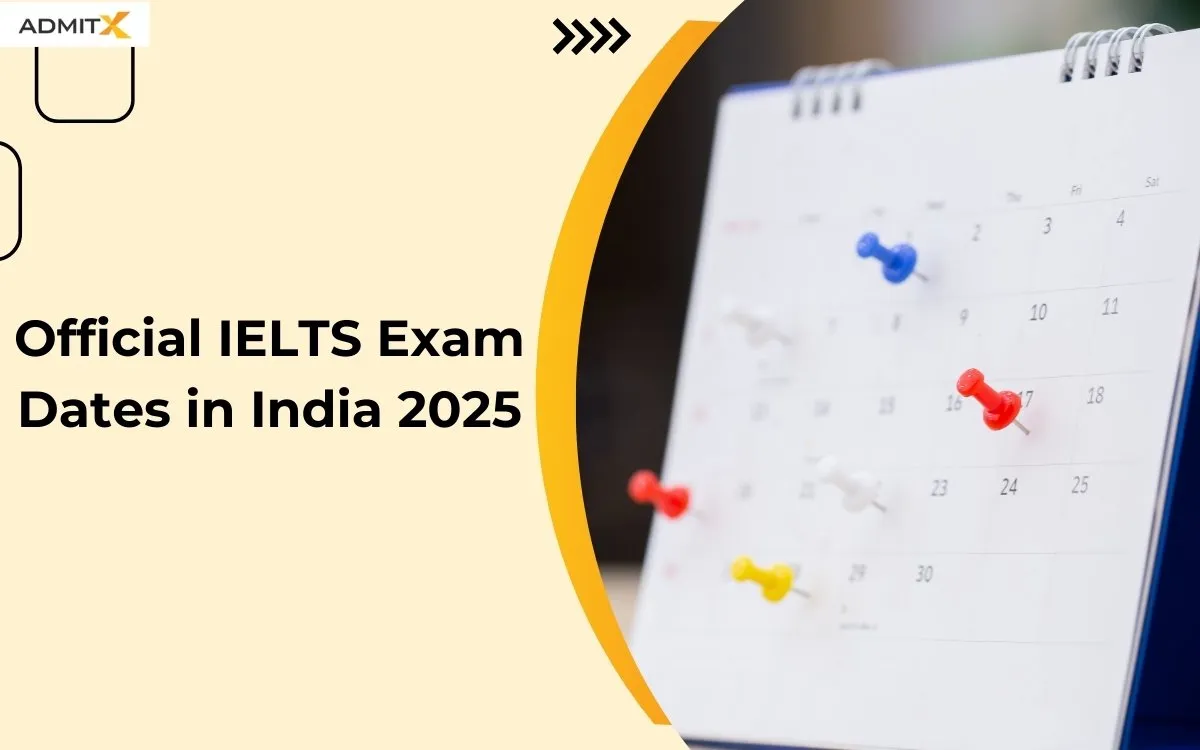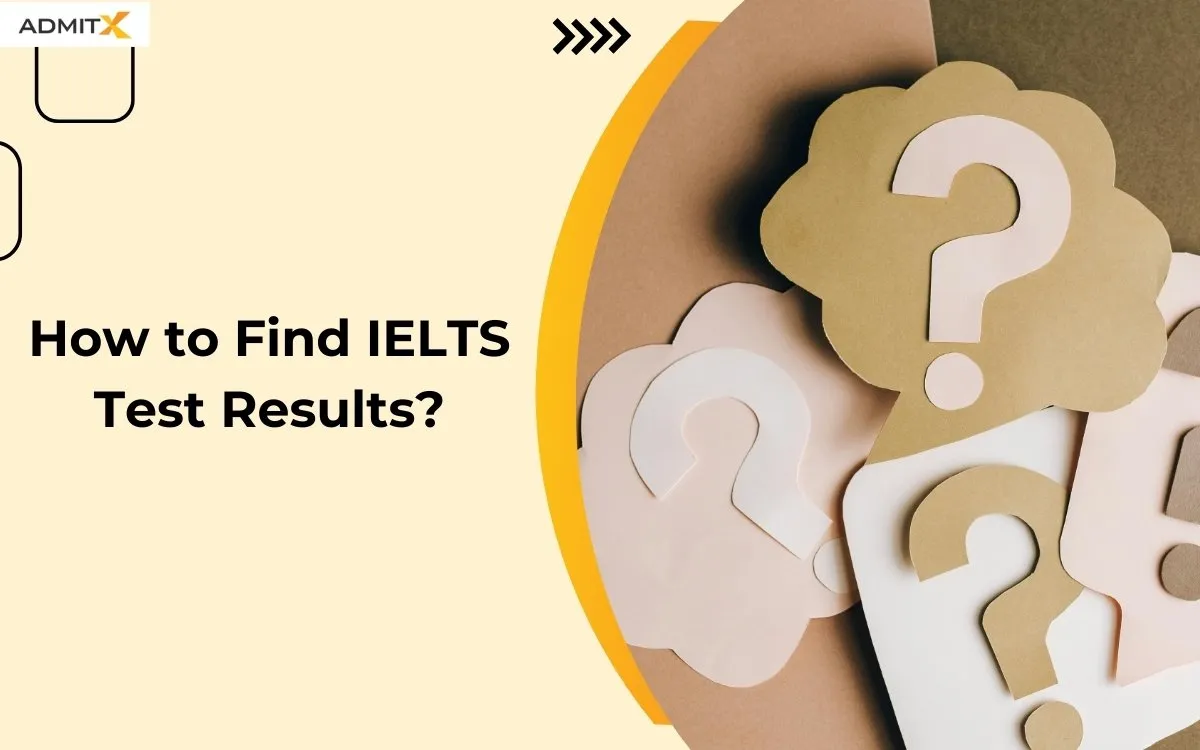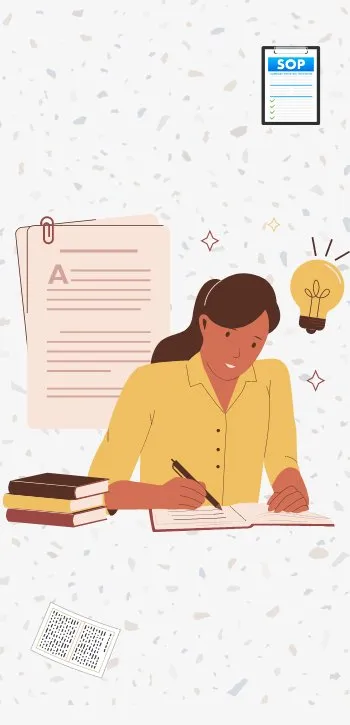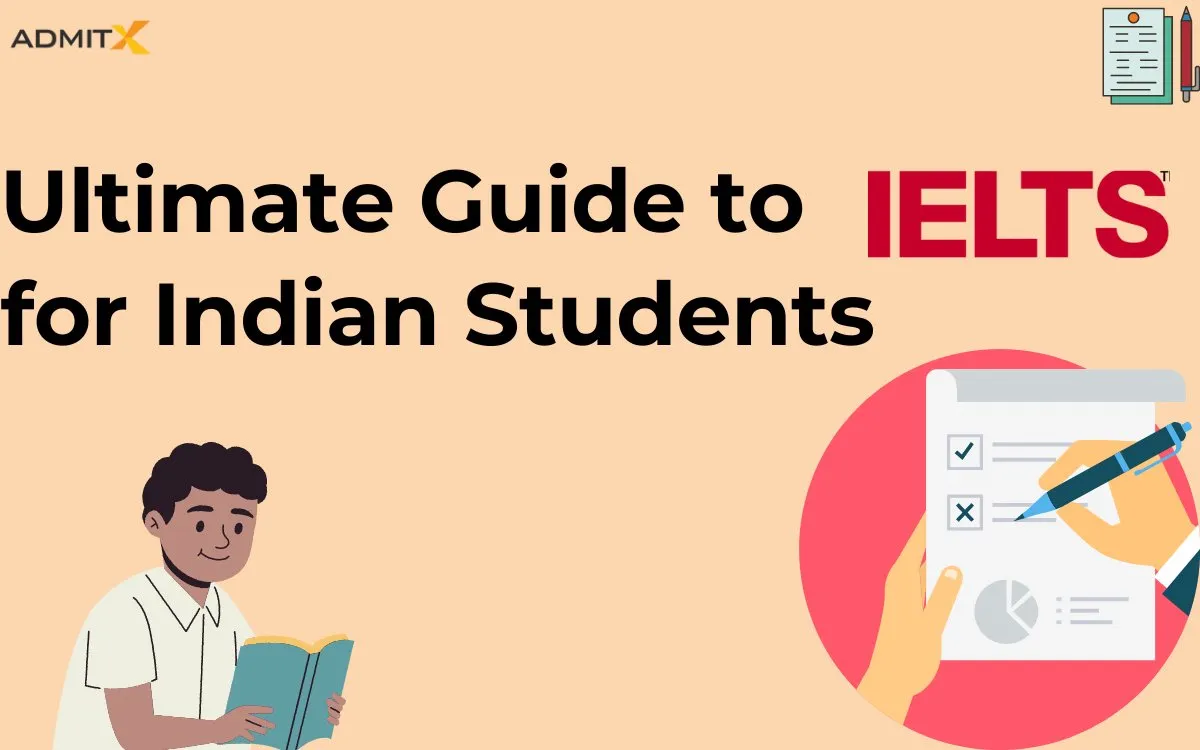
IELTS Exam Guide: Ace Your English Language
IELTS, or International English Language Testing System, is a world-renowned English language proficiency test specifically designed to test English language skills. It helps to achieve the dream of studying, working, and living abroad, where English is used as a primary language, or its proficiency is required.
The IELTS exam is conducted worldwide for academic institutions and professional organisations in countries like the USA, Australia, New Zealand, the UK, Ireland, Canada and more. This blog has discussed the IELTS exam, including its pattern, syllabus, registration process, preparation strategy, mock tests, and more.
Key Highlights
| IELTS Full Form | International English Language Testing System |
|---|---|
| IELTS Accepted Countries | USA, UK, Canada, France, Germany |
| Conducted By | British Council and IDP |
| Mode of Exam | Offline and Online |
| IELTS Exam Fees | INR 17,000 |
| Safe Score For IELTS | 6.5 or higher |
| AdmitX Free IELTS Course Link |
Types of IELTS Exam
Following is an overview of different types of IELTS exams, including content, duration, format and validity.
| Type of IELTS | Content | Exam Duration | Format | Validity |
|---|---|---|---|---|
| IELTS Academic | Academic English based on college/university coursework | 2 Hours 45 Minutes | Listening Writing Reading Speaking | 2 Years |
| IELTS General Training Test | Academic English based on university coursework and English used in everyday life | 2 Hours 45 Minutes | Listening Writing Reading Speaking | 2 Years |
| IELTS Life Skills | The English language is used in everyday life, such as at the workplace and in society | Varies from 16-20 minutes, depending on the level | Discussion on tasks related to: Personal details Friends Family Buying goods Work Health Leisure etc. | 2 Years |
IELTS Band Score
IELTS test takers receive a report with an overall band score (0-9) and section scores (Listening, Reading, Writing, Speaking).
The overall score is the average of the four section scores, rounded to the nearest half band.
| Band Score | Level of Proficiency |
|---|---|
| 0 | No answer given |
| 1 | No ability to use the language |
| 2 | Difficulty in understanding written and spoken English |
| 3 | Frequent breakdown in communication |
| 4 | Basic competence is limited |
| 5 | Partial command of the English language |
| 6 | Effective command of the English language |
| 7 | Good command of the English language |
| 8 | Fully operational command of the English language |
| 9 | Expertise in the English language |
IELTS Exam Pattern
| Sections | Questions/Task | Time Duration | Description |
|---|---|---|---|
| Listening | 40 questions | 30 minutes | Hearing recorded conversations and answering the questions based on it |
| Academic Reading | 40 questions | 60 minutes | Reading the descriptive passages and answering the questions |
| Academic Writing | 2 tasks | 40 minutes | Written discussion on a given point of view, topic or argument |
| Speaking | 3 topic | 11-14 minutes | Stating opinions or answers orally based on topics related to a topic like a study, home, family, etc. |
IELTS Academic Exam Pattern: Breakdown of Sections
| Section | Content | No. of Questions | Time Duration | Question Type |
|---|---|---|---|---|
| Listening | Recorded conversations and monologues | 40 | 30 minutes + 10 minutes for writing | MCQs, Matching, Diagram labeling, Form/Note completion, Sentence completion, Short answer questions |
| Reading | Academic texts from books, journals, newspapers, and online resources | 40 | 60 minutes | MCQs, True/False, Identifying claims, Matching information, Short answer questions, Diagram labeling, Summary completion, Sentence completion, Matching sentence endings |
| Writing | Task 1: Describing a visual (graph, chart, diagram, etc.) Task 2: Writing an essay on a given topic | 2 tasks | 60 minutes | Task 1: Description Task 2: Essay writing (argumentative, discursive, or report) |
| Speaking | Face-to-face interview with an examiner | 3 parts | 11-14 minutes | Part 1: Introduction and general questions Part 2: Long turn (topic card) Part 3: Discussion |
How to Register for the IELTS Exam
One can apply to appear in the IELTS Exam in three ways. They are:
- Online Registration
- Offline Registration
- Registration by Courier
1. Online Registration
- Log on to the official IELTS website here.
- Select the option ‘Register for IELTS’.
- Select the test day and test city.
- Complete the application form by filling in personal details and other mandatory information.
- Pay the IELTS fees using a credit card.
2. Offline Registration
- Walk into your nearest IDP Branch/head office.
- Fill out the application form available at the office.
- Sign the terms and conditions provided.
- Attach a copy of your passport.
- Pay the IELTS fee either by credit/debit card/ATM card.
- Payment can also be made by demand draft (drawn in favour of ‘IDP Education India Private Limited, payable at New Delhi’).
3. Registration by Courier
- Download the application form from the official IELTS website.
- Fill out the application form.
- Sign the terms and conditions provided.
- Attach a copy of your passport.
- Append the demand draft for the test fee (drawn in favour of ‘IDP Education India Private Limited, payable at New Delhi’).
- Send the duly filled application with all necessary documents to the following address:
IDP Education India Pvt. Ltd.
Global Gateway Towers, Tower-B, 5th Floor, Sikanderpur Ghosi, Sector-26, M.G. Road, Gurugram -122002, Haryana, India
IELTS Exam Registration: Required Documents & Fees
- Valid Passport: A passport with a name, photo, and signature is mandatory.
- Passport-sized Photo: A recent color photograph.
- Registration Fee: Approximately INR 17,000 or USD 203.
IELTS Study Plan
The chart illustrates each week’s objectives and their respective focus area.
| Weeks | Focus Area | Objective |
|---|---|---|
| Week 1 | Familiarisation with the IELTS exam format | Write down the target score Determine which skills you need to improve Take the initial practice test Start creating and following the schedule |
| Week 2 | Listening Section (Accent, pronunciation, fluency, judging the speaker’s tone) | Listen to English podcasts from different accents every day Make notes on the relevant point Draw your own opinion, idea and conclusion |
| Week 3 | Reading Section (Vocabulary, sentence formation, pronunciation, synonyms) | Read full-fledged English newspapers and magazines daily Make notes on relevant topics Draw opinions and possible arguments |
| Week 4 | Writing Section (Comprehension of sentence structure, tone, imagination, answer making, formal communication) | Write an extended essay every day on some common topic. Filter out the essential points Draw your conclusions and ideas on it Write a journal every day to get better fluency |
| Week 5 | Speaking Section (Vocabulary, fluency, pronunciation, tone) | Try to talk about the topic which seems interesting to you for 5 minute Gradually increase the speaking time duration to 9-10 minutes Record each speaking session and get it evaluated by the tutor Communicate with family, friends and known ones in the English language |
| Week 6 | Test and Practice | Revise the content section-wise Give mock tests and full-length practice tests |
Best Sources of IELTS Mock Test
Below is a list of some of the best sources offering IELTS mock tests, previous year’s IELTS question papers, and preparation guides:
- IDP IELTS Practice Test
- British Council’s IELTS Practice Tests
- The Official Cambridge Guide to IELTS
- IELTS 18 Academic by Cambridge
- IELTS Online Test Prep by Magoosh
- IDP IELTS Mobile application
Key Takeaways By AdmitX
If you’re aiming to study or work abroad, the IELTS exam could be your gateway to international opportunities. This globally recognised test, accepted by nearly 12,000 academic and professional bodies across English-speaking countries, evaluates your language proficiency through a comprehensive band scoring system.
Want to improve your IELTS score? AdmitX offers a free IELTS course to help you achieve your academic and professional goals. Our expert teachers will guide you through all four sections of the IELTS exam. You’ll get tips, practice materials, and the support you need to succeed.
FAQs
What is a good IELTS Score?
IELTS scores are expressed in band scores ranging from band 0 to band 9. An IELTS score of 6.5-7.0 is considered a good score. It signifies the candidate’s level of competency in the English language.
Are there any eligibility criteria for the IELTS Exam?
No, anyone aged 16 or above can appear for the exam, irrespective of gender, nationality and educational background.
How many attempts are allowed for the IELTS Exam?
There are no restrictions on the number of attempts, as students can appear for the IELTS exams as often as they want.
How long is the IELTS exam?
The total test duration is approximately 2 hours and 45 minutes. It consists of four sections: Listening (30 minutes), Reading (60 minutes), Writing (60 minutes), and Speaking (11-14 minutes), which can be scheduled on the same day or within a week of the other sections.
How is the IELTS scored?
The IELTS uses a band scoring system from 0 to 9, with each band representing a different level of English language competence.
Most universities and employers look for a band score between 6.0 and 7.5, depending on their specific requirements.
If you are an aspirant looking to study at your dream university, book an appointment with AdmitX today and start your applications early to avail yourself of all the benefits.



